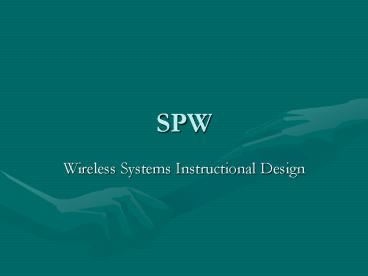SPW - PowerPoint PPT Presentation
Title:
SPW
Description:
SPW Wireless Systems Instructional Design Introduction SPW = Signal Processing WorkSystem by Cadence An integrated environment for system-level design, simulation ... – PowerPoint PPT presentation
Number of Views:53
Avg rating:3.0/5.0
Title: SPW
1
SPW
- Wireless Systems Instructional Design
2
Introduction
- SPW Signal Processing WorkSystem by Cadence
- An integrated environment for system-level
design, simulation, and implementation that is
built around the convergence simulation
architecture combining datapath and control
constructs in a single simulation environment
3
Introduction
- Overview of the functionality
- Main features
- Component libraries
- BDE
- Signal Calculator
- Simulatior
- Custom block design
- HDS, Fixed-point, FSM
4
Introduction (PR)
- Specify, capture, and simulate your complete
system design at multiple levels of abstraction
(e.g. algorithms, hardware and software
architectures, VHDL and Verilog languages). - Test and verify your complete system design
within a "real-world" context. - Analyze hardware/software architectural
trade-offs within the context of the overall
system. - Maximize design reuse at all stages in the design
flow so you can avoid "reinventing the wheel. - Address the convergence of system-level and
chip-level design
5
Component libraries
- Components are called blocks and are organized
into libraries - Communications library
- Wireless LAN library 802.11a/b/g, Bluetooth
- Cellular systems libraries GSM, IS-136, WCDM
- Each block consists of 3 files (views)
- detail views - containing the functionality of
the block - symbol view- graphically representing and hiding
the block detail - params view (parameter screens) - containing
editable parameter values
6
BDE
- The Block Diagram Editor (BDE) is the basic
design environment of the SPW - Design is created by selecting blocks and
connecting them in the signal flow network - A design includes functional objects, such as
blocks that process signals wires, ports, and
connectors that carry signals textual objects
such as parameters and graphic objects such as
the lines, circles, boxes, and text labels that
illustrate and describe the functional objects - Parameter Expression Language (PEL)
7
Signal Calculator
- As the name implies extends the notion of
hand-held calculator to all types of signal
waveforms - read in signal data output files from the
Simulation Program Builder - Features
- Can generate sine, square, triangle, sawtooth,
phasor, impulse, step, ramp, constant, random
bits, uniform noise, or Gaussian noise - create and edit real and complex signals
- edit and analyze fixed-point signals
- perform real-time signal acquisition and playback
8
Simulator
- Two simulators
- SPB-Interpreted (SPB-I)
- SPB-Compiled (SPB-C)
- Simulation stages
- Netlist Generation
- Netlist Flattening and Scheduling
- Simulation Run
- In addition to the output signals, the simulator
produces three types of messages notes,
warnings, and errors
9
Simulator (cont.)
- Simulation types
- single-rate - universal sampling frequency
- synchronous dataflow (multirate)
- dynamic dataflow (dynamic multirate) - the design
is scheduled dynamically - "Hold" Input - enables dynamic behavior of
single-rate
10
Simulator (cont)
- SPB-I Simulator
- SPB-I is generally the best simulator for
initially developing and debugging a DSP design. - It offers a simulation debugger and the best
dynamic error handling capabilities (for example,
dynamic overflow). - The turnaround time for design changes is usually
shorter with SPB-I because it does not require
recompiling the simulation program for each
design change. - SPB-I is often more efficient than SPB-C for
exploring the effects of parameter changes. - Each block in the design needs to have an SPB-I
model to use this simulator. - Generally slower simulation performance than
SPB-C.
11
Simulator (cont.)
- SPB-C Simulator
- After debugging a design with SPB-I, you can use
SPB-C as a simulation accelerator. - SPB-C generally gives the fastest simulation
performance of all the simulators. - Significant performance improvements in
multi-clock designs and fixed point arithmetic. - All blocks in the design must have SPB-C models.
12
Simulator (cont.)
- The Simulation Manager is used to
- Specify the design to be simulated, the type of
SPW simulator, the simulation run length, and
other simulation parameters - Override or sweep parameters in the design.
- Insert probes into the design to monitor internal
signals. - Initiate one or more simulation runs on the local
node and/or remote nodes. - Initiate debugging sessions with the SPB-I or
SPB-C debugger. - Manage the results of multiple simulation runs.
- Transfer simulation results to the Signal
Calculator (SigCalc).
13
Simulator (cont.)
- Additional simulators
- SPB-C Export allows you to export C models of SPW
designs to other vendor's simulators. - SPW-NC directly connects SPW and one of the NC
simulators to create a co-simulation. - SPW-AMS enables you to co-simulate SPW and AMS
blocks in a design. - SPW-LPS helps you to obtain a power-centric
analysis of a system design - RTL Link allows you to simulate your entire
design as HDL.































